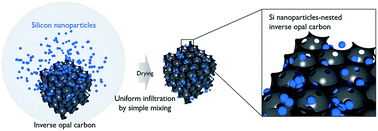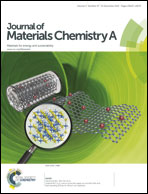Si nanoparticles-nested inverse opal carbon supports for highly stable lithium-ion battery anodes†
Abstract
The confinement and uniform dispersion of Si nanoparticles (NPs) in a carbon matrix is a promising strategy to accommodate the problematic large volume change of high-capacity Si-based anodes during charging/discharging in lithium-ion batteries. Here, we introduced an inverse opal carbon (IOC) matrix for Si NPs dispersion. A macroporous, highly interconnected porous structure of IOCs allowed uniform dispersion of Si NPs by simple mixing, and large voids that surrounded the Si NPs. The Si NPs/IOC composite anode exhibited a specific capacity up to 1233 mA g−1 with 40 wt% Si NPs content, which was 4.1 times higher than the IOC anode. The capacity retention over 50 cycles for the Si NPs/IOC anode (40 wt% Si NPs/IOC) was as high as 81%, whereas the Si NPs anode revealed only 48% retention. The specific capacity was also maintained up to 70% as the current density increased 20-fold. These enhancement of the capacity retention and the current density were attributed to the efficient accommodation of the Si volume change in the IOC structure and facile charge transport in and through the IOC matrix. We believe this simple geometry-derived approach for the dispersion of nanoparticles may be advantageous in the practical application of high-capacitive nanomaterials for next-generation lithium ion battery (LIB) development.


 Please wait while we load your content...
Please wait while we load your content...